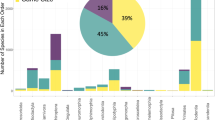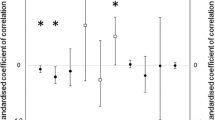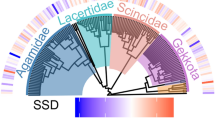Abstract
Variation in sexual size dimorphism (SSD) is a widespread phenomenon and is commonly attributed to variation in sex-specific patterns of selection. According to Rensch’s rule, SSD increases with increasing body size when males are the larger sex, and decreases when females are the larger sex. Using data from 17 populations of Andrew’s toad (Bufo andrewsi), we tested whether the patterns of SSD conform to Rensch’s rule. Using field experiments, we also evaluated the hypothesis that sexual selection favours large male body size and that fecundity selection favours large female body size. The results revealed that the degree of SSD increased with increasing mean size in females, consistent with the inverse of Rensch’s rule. Although experiments revealed evidence for a large-male mating advantage, selection for large male size was weak at best, and hence unlikely to be an important source of variation in SSD. However, fecundity selection favouring large females was evident, and likely to explain the observed inverse of Rensch’s rule. After correcting male and female body size for age differences, the patterns of SSD remained the same, suggesting that the intra- and interpopulational variation in SSD is not driven by sex differences in age structure. Hence, these findings suggest that the strong fecundity selection favouring large females drives the evolution of female-biased SSD in B. andrewsi, providing an explanation for the inverse of Rensch’s rule. As such, the study provides an important addition to the small body of literature that uses an intraspecific approach to demonstrate the inverse of Rensch’s rule.





Similar content being viewed by others
References
Abouheif E, Fairbairn DJ (1997) A comparative analysis of allometry for sexual size dimorphism: assessing Rensch’s rule. Am Nat 149:540–562
Andersson M (1994) Sexual selection. Princeton University Press, Princeton
Angilletta MJ, Dunham AE (2003) The temperature-size rule in ectotherms: simple evolutionary explanations may not be general. Am Nat 162:332–342
Arak A (1988) Sexual size dimorphism in body size: a model and a test. Evolution 42:820–825
Berven KA (1982) The genetic basis of altitudinal variation in the wood frog Rana sylvatica. I. An experimental analysis of life history traits. Evolution 36:962–983
Blanckenhorn WU, Dixon AFG, Fairbairn DJ, Foellmer MW, Gibert P, van der Linde K, Meier R, Nylin S, Pitnick S, Schoff C, Signorelli M, Teder T, Wiklund C (2007) Proximate causes of Rensch’s rule: does sexual size dimorphism in arthropods result from sex differences in developmental time? Am Nat 169:245–257
Ceballos CP, Valenzuela N (2011) The role of sex-specific plasticity in shaping sexual dimorphism in a long-lived vertebrate, the snapping turtle Chelydra serpentina. Evol Biol 38:163–181
Ceballos CP, Adams DC, Iverson JB, Valenzuela N (2013) Phylogenetic patterns of sexual size dimorphism in turtles and their implications for Rensch’s rule. Evol Biol 40:194–208
Clutton-Brock TH, Harvey PH, Rudder B (1977) Sexual dimorphism, socioeconomic sex ratio and body weight in primates. Nature 269:797–800
Cox RM, Kelly SL, John-Adler HB (2003) A comparative test of adaptive hypotheses for sexual size dimorphism in lizards. Evolution 57:1653–1669
Dale J, Dunn PO, Figuerola J, Lislevand T, Székely T, Whittingham LA (2007) Sexual selection explains Rensch’s rule of allometry for sexual size dimorphism. Proc R Soc Lond B 274:2971–2979
Darwin C (1871) The descent of man, and selection in relation to sex. Murray, London
De Lisle SP, Rowe L (2013) Correlated evolution of allometry and sexual dimorphism across higher taxa. Am Nat 182:630–639
Emlen ST, Oring LW (1977) Ecology, sexual selection, and the evolution of mating systems. Science 197:215–223
Fairbairn DJ (1997) Allometry for sexual size dimorphism: pattern and process in the coevolution of body size in males and females. Ann Rev Ecol Sys 28:659–687
Fairbairn DJ (2005) Allometry for sexual size dimorphism: Testing two hypotheses for Rensch’s rule in the water strider Aquarius remigis. Am Nat 166:S69–S84
Fairbairn DJ, Preziosi RF (1994) Sexual selection and the evolution of allometry for sexual size dimorphism in the water strider (Aquarius remigis). Am Nat 144:101–118
Fei L, Ye CY (2001) The colour handbook of amphibians of Sichuan. China Forestry, Beijing
Frost DR (2013) Amphibian species of the world: an online reference. American Museum of Natural History, New York
Frynta D, Baudyšová J, Hradcová P, Faltusová K, Kratochvíl L (2012) Allometry of sexual size dimorphism in domestic dog. PLoS ONE 7:e46125
Han X, Fu JZ (2013) Does life history shape sexual size dimorphism in anurans? A comparative analysis. BMC Evol Biol 13:27
Hedrick AV, Temeles EJ (1989) The evolution of sexual dimorphism in animals: hypotheses and tests. Trends Ecol Evol 4:136–138
Herczeg G, Gonda A, Merilä J (2010) Rensch’s rule inverted female-driven gigantism in nine-spined stickleback Pungitius pungitius. J Anim Ecol 79:581–588
Johansson F, Crowley PH, Brodin T (2005) Sexual size dimorphism and sex ratios in dragonflies (Odonata). Biol J Linn Soc 86:507–513
Kelly CD, Bussiere LF, Gwynne D (2008) Sexual selection for male mobility in a giant insect with female-biased size dimorphism. Am Nat 172:417–423
Kelly CD, Folinsbee EK, Adams CD, Jennions DM (2013) Intraspecific sexual size and shape dimorphism in an Australian freshwater fish differs with respect to a biogeographic barrier and latitude. Evol Biol 40:408–419
Kupfer A (2007) Sexual size dimorphism in amphibians: an overview. In: Fairbairn DJ, Blanckenhorn WU, Székely T (eds) Sex, size and gender roles: evolutionary studies of sexual size dimorphism. Oxford University Press, Oxford, pp 50–59
Lande R, Arnold ST (1983) The measurement of selection on correlated characters. Evolution 37:1210–1226
Laugen AT, Laurila A, Merilä J (2003) Latitudinal countergradient variation in the common frog (Rana temporaria) developmental rates—evidence for local adaptation. J Evol Biol 16:996–1005
Laugen AT, Jönsson I, Laurila A, Söderman F, Merilä J (2005) Do common frogs (Rana temporaria) follow Bermann’s rule? Evol Ecol Res 7:717–731
Laurila A, Karttunen S, Merilä J (2002) Adaptive phenotypic plasticity and genetics of larval life histories in two Rana temporaria populations. Evolution 56:617–627
Lengkeek W, Didderen K, Cote IM, van der Zee EM, Snook RC, Reynolds JD (2008) Plasticity in sexual size dimorphism and Rensch’s rule in Mediterranean blennies (Blenniidae). Can J Zool 86:1173–1178
Liao WB (2009) Elevational variation in the life-history of anurans in a subtropics montane forest of Sichuan, southwestern China. PhD thesis, Wuhan University, Wuhan
Liao WB (2013) Evolution of sexual size dimorphism in a frog obeys the inverse of Rensch’s rule. Evol Biol 40:493–499
Liao WB, Chen W (2012) Inverse Rensch-rule in a frog with female-biased sexual size dimorphism. Naturwissenschaften 99:427–431
Liao WB, Lu X (2009a) Male mate choice in the Andrew’s toad Bufo andrewsi: a preference for larger females. J Ethol 27:413–417
Liao WB, Lu X (2009b) Sex recognition by male Andrew’s toad Bufo andrewsi in a subtropical montane region. Behav Proc 82:100–103
Liao WB, Lu X (2010a) Age and growth of a subtropical high-elevation torrent frog, Amolops mantzorum, in western China. J Herpetol 44:172–176
Liao WB, Lu X (2010b) Age structure and body size of the Chuanxi tree frog Hyla annectans chuanxiensis from two different elevations in Sichuan (China). Zool Anz 248:255–263
Liao WB, Lu X (2011) Proximate mechanisms leading to large male-mating advantage in the Andrew’s toad Bufo andrewsi. Behaviour 148:1087–1102
Liao WB, Lu X (2012) Adult body size = f (initial size + growth rate × age): explaining the proximate cause of Bergman’s cline in a toad along altitudinal gradients. Evol Ecol 26:579–590
Liao WB, Zeng Y, Zhou CQ, Jehle R (2013) Sexual size dimorphism in anurans fails to obey Rensch’s rule. Front Zool 10:10
Lindenfors P, Gittleman JL, Jones KE (2007) Sexual size dimorphism in mammals. In: Fairbairn DJ, Blanckenhorn WU, Székely T (eds) Sex, size and gender roles: evolutionary studies of sexual size dimorphism. Oxford University Press, Oxford, pp 16–26
Lu D, Zhou CQ, Liao WB (2014) Pattern of sexual size dimorphism supports the inverse Rensch’s rule in two frog species. Anim Biol 64:87–95
Macey JR, Shulte JA II, Larson A, Fang Z, Wang Y, Tuniyev BS, Papenfuss TJ (1998) Phylogenetic relationships of toads in the Bufo bufo species group from the eastern escarpment of the Tibetan Plateau: a case of vicariance and dispersal. Mol Phylogenet Evol 9:80–87
Monnet JM, Cherry MI (2002) Sexual size dimorphism in anurans. Proc R Soc Lond B 269:2301–2307
Morrison FC, Hero JM (2003) Geographic variation in life-history characteristics of amphibians: a review. J Anim Ecol 72:270–279
Patrelle C, Hjernquist MB, Laurila A, Söderman F, Jönsson I, Merilä J (2012) Sex differences in age structure, growth rate and body size of common frogs Rana temporaria in the subarctic. Polar Biol 35:1505–1513
Polák J, Frynta D (2010) Patterns of sexual size dimorphism in cattle breeds support Rensch’s rule. Evol Ecol 24:1255–1266
Raihani G, Székely T, Serrano-Meneses MA, Pitra C, Goriup P (2006) The influence of sexual selection and male agility on sexual size dimorphism in bustards (Otididae). Anim Behav 71:833–838
Remeš V, Székely T (2010) Domestic chickens defy Rensch’s rule: sexual size dimorphism in chicken breeds. J Evol Biol 23:2754–2759
Rensch B (1950) Die Abhängigkeit der relativen sexualdifferenz von der Körpergröße”. Bonn Zool Beitr 1:58–69
Selander RK (1966) Sexual dimorphism and differential niche utilization in birds. Condor 68:113–151
Shine R (1979) Sexual selection and sexual dimorphism in the amphibia. Copeia 1979:297–306
Smirina EM (1994) Age determination and longevity in Amphibians. Gerontology 40:133–146
Smith RJ (1999) Statistics of sexual size dimorphism. J Hum Evol 36:423–459
Sokal RR, Rohlf FJ (1981) Biometry: the principles and practice of statistics in biological research. Freeman, San Francisco
Steele DB, Siepielski AM, McPeek MA (2011) Sexual selection and temporal phenotypic variation in a damselfly population. J Evol Biol 24:1517–1532
Stillwell RC, Blanckenhorn WU, Teder T, Davidowitz G, Fox CW (2010) Sex differences in phenotypic plasticity affect variation in sexual size dimorphism in insects: from physiology to evolution. Annu Rev Entomol 55:227–245
Stuart-Fox D (2009) A test of Rensch’s rule in dwarf chameleons (Bradypodion spp.), a group with female-biased sexual size dimorphism. Evol Ecol 23:425–433
Sutter NB, Mosher DS, Ostrander EA (2008) Morphometrics within dog breeds are highly reproducible and dispute Rensch’s rule. Mamm Genom 19:713–723
Székely T, Reynolds JD, Figuerola J (2000) Sexual size dimorphism in shorebirds, gulls and alcids: the influence of sexual and natural selection. Evolution 54:1404–1413
Székely T, Freckleton RP, Reynolds JD (2004) Sexual selection explains Rensch’s rule of size dimorphism in shorebirds. Proc Natl Acad Sci USA 101:12224–12227
Teder T, Tammaru T (2005) Sexual size dimorphism within species increases with body size in insects. Oikos 108:321–334
Walker SPW, McCormick MI (2009) Sexual selection explains sex-specific growth plasticity and positive allometry for sexual size dimorphism in a reef fish. Proc R Soc Lond B 276:3335–3343
Wells KD (2007) The Ecology and Behaviour of Amphibians. University of Chicago Press, Chicago
Young KA (2005) Life-history variation and allometry for sexual size dimorphism in Pacific salmon and trout. Proc R Soc Lond B 272:167–172
Zhang LX, Lu X (2013) Sexual size dimorphism in anurans: ontogenetic determination revealed by an across-species comparison. Evol Biol 40:84–91
Acknowledgments
We are grateful to Shang Ling Lou, De Lu and Long Jin for their help in sampling and fieldwork, as well as to Jacquelin DeFaveri for checking the language of this manuscript. Financial support was provided by the National Natural Sciences Foundation of China (31471996, 31101633 to W.B.L.), Sichuan Province Outstanding Youth Academic Technology Leaders Program (2013JQ0016 to W.B.L.), the Innovative Team Foundation of China West Normal University (to W.B.L.) and Academy of Finland (265211 to J.M.). The reported experiments comply with the current laws of China concerning animal experimentation, and permission to collect toads was received from the Ethical Committee for Animal experiments in China.
Author information
Authors and Affiliations
Corresponding author
Additional information
Communicated by Raoul Van Damme.
Rights and permissions
About this article
Cite this article
Liao, W.B., Liu, W.C. & Merilä, J. Andrew meets Rensch: sexual size dimorphism and the inverse of Rensch’s rule in Andrew’s toad (Bufo andrewsi). Oecologia 177, 389–399 (2015). https://doi.org/10.1007/s00442-014-3147-8
Received:
Accepted:
Published:
Issue Date:
DOI: https://doi.org/10.1007/s00442-014-3147-8




